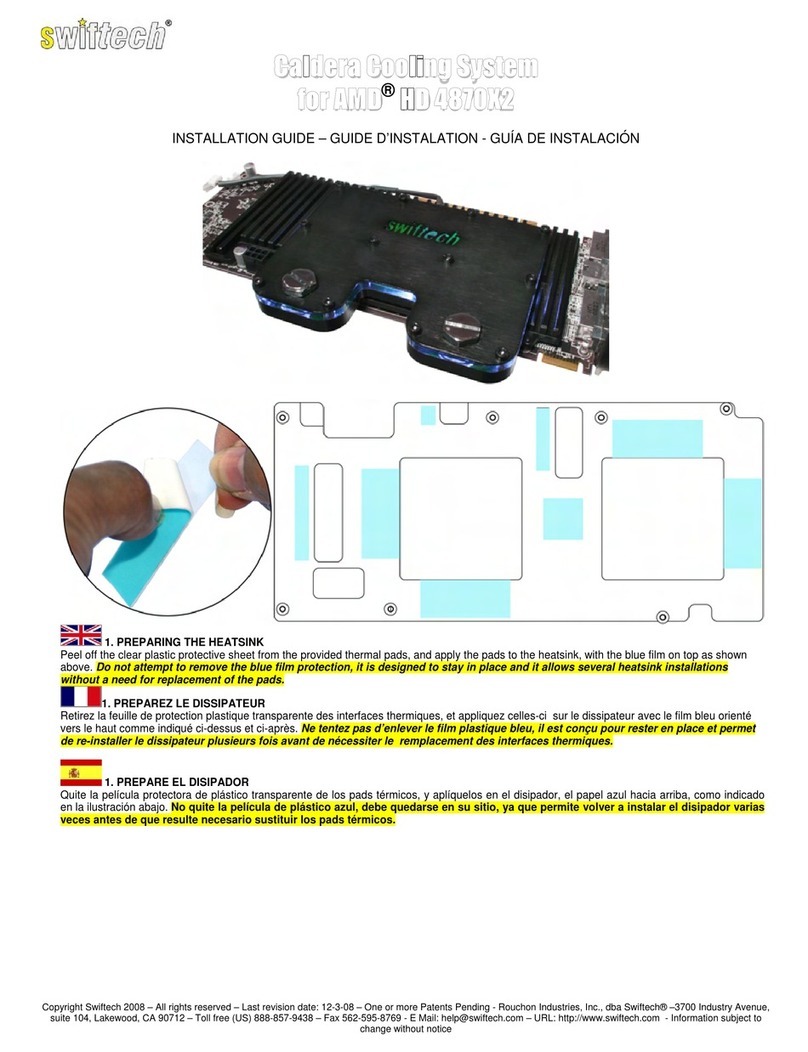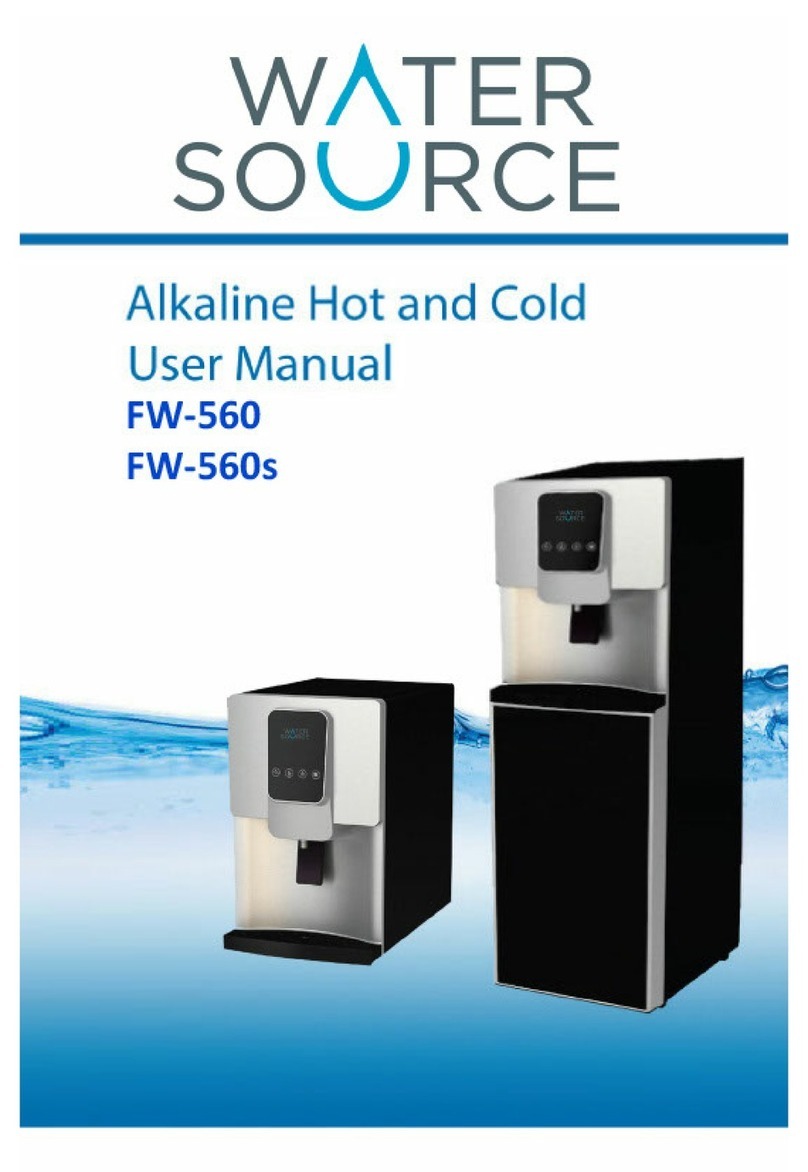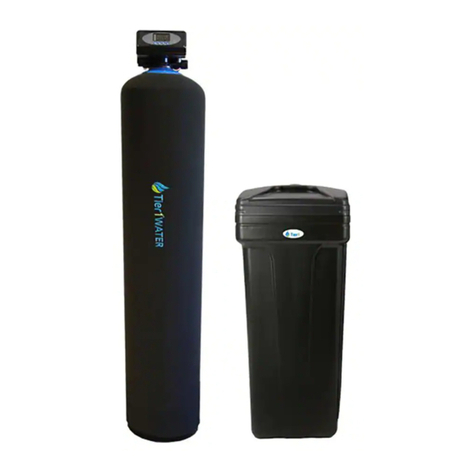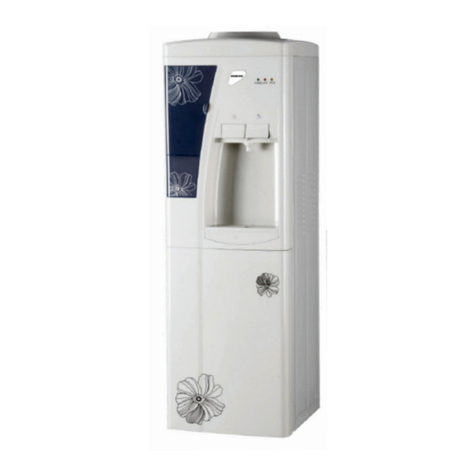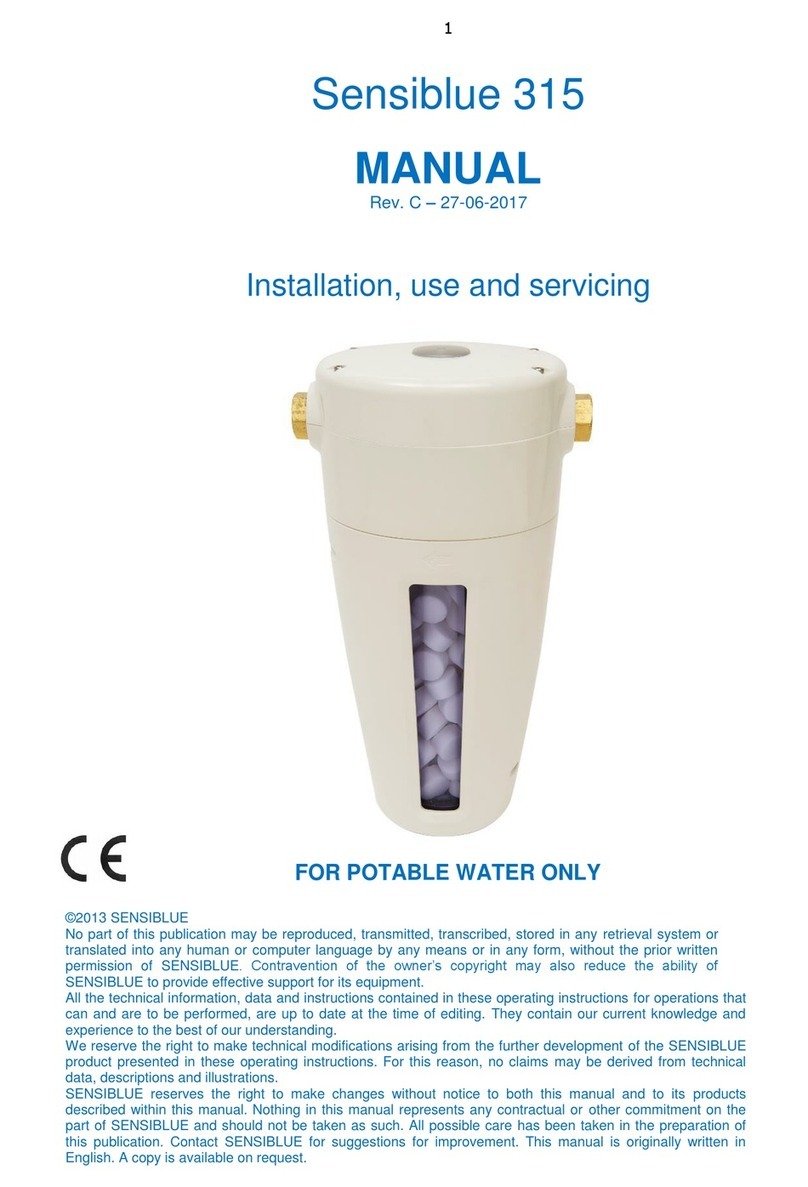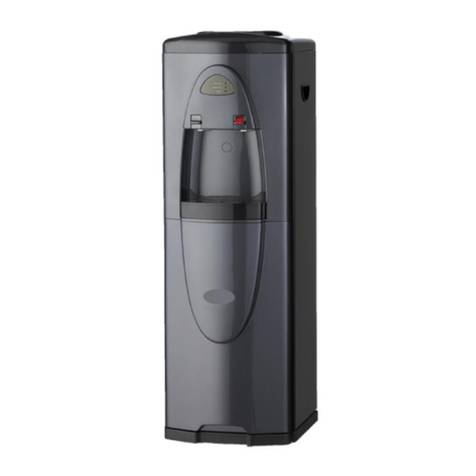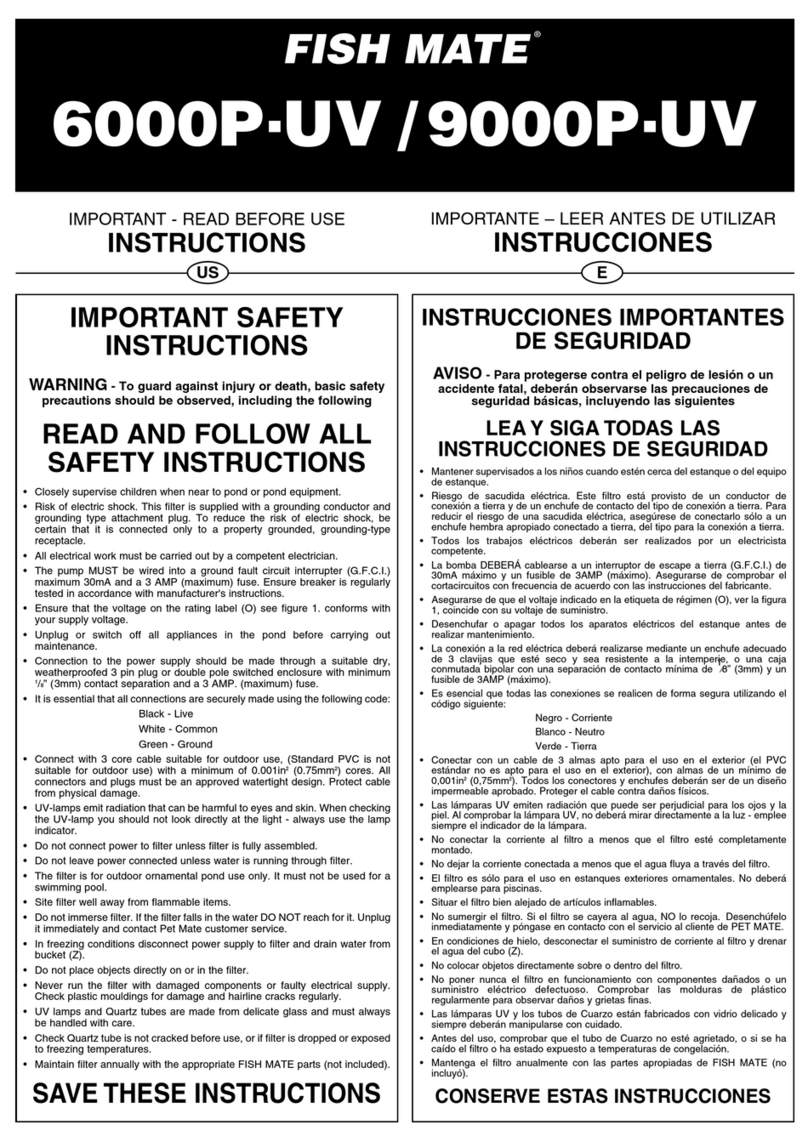Clack WS1 Series Instruction manual

WS1”, 1.5” & 2” Series Watersoftener
Installation Operation Maintenance Manual
SIMPWS1 REV3 13/07/11 PAGE 1 OF27
Installation
Operation
Maintenance
Manual
Simplex Water Softeners
With WS1”, 1.5” & 2” Series Valve
Models 20 ltr - 750 ltr

WS1”, 1.5” & 2” Series Watersoftener
Installation Operation Maintenance Manual
SIMPWS1 REV3 13/07/11 PAGE 2 OF27
1.0 PARTS LIST
..................................................................................................................................3
1.1 BASIC PARTS LIST.....................................................................................................................3
1.2 MISSING OR DAMAGED GOODS..............................................................................................3
2.0 TEMPORARY STORAGE
..............................................................................................................3
3.0 REGENERATION
..........................................................................................................................3
3.1 The Regeneration Process....................................................................................................3
3.2 METER CONTROL OF REGENERATION.....................................................................................4
3.3 TIME CLOCK CONTROL OF REGENERATION INITIATION..........................................................4
4.0 PRE-INSTALLATION CHECKS
......................................................................................................4
4.1 MECHANICAL...........................................................................................................................4
4.1.1 Foundation/Drainage .......................................................................................................4
4.1.2 Operating Space ...............................................................................................................5
4.1.3 Incoming Water................................................................................................................5
4.1.4 Pipework...........................................................................................................................5
4.1.5 Water Supply Company Requirements ............................................................................5
4.2 ELECTRICAL ..............................................................................................................................6
5.0 ASSEMBLY/INSTALLATION
........................................................................................................6
5.1 MECHANICAL...........................................................................................................................6
5.1.1 Pipework...........................................................................................................................6
5.1.2 Assembly...........................................................................................................................6
5.2 Options ....................................................................................................................................7
5.2.1 No Hard Water Bypass .....................................................................................................7
5.2.2 Differential Pressure Switch (dP)......................................................................................8
6.0 PROGRAMMING
.........................................................................................................................8
6.1 INTRODUCTION .......................................................................................................................8
6.2 CONTROLLER SETTING.............................................................................................................8
6.2.1 Setting the Time of Day ....................................................................................................9
6.3 Factory Programming
..........................................................................................................10
7.0 COMMISIONING ....................................................................................................................13
8.0 ROUTINE MONITORING.............................................................................................................14
9.0 FAULT FINDING AND RECTIFICATION ........................................................................................15
9.1 NO FLOW TO SERVICE ...........................................................................................................15
9.2 POOR TREATED WATER QUALITY..........................................................................................15
9.3 NO REGENERATION ...............................................................................................................16
9.4 UNSATISFACTORY CAPACITY BETWEEN REGENERATIONS....................................................16
10.0 WARRANTY AND SERVICE ...................................................................................................16
10.1 AFTER SALE WARRANTY ......................................................................................................16
11.0 Technical Data
........................................................................................................................17
11.1 Process and Operating Data
........................................................................................17
11.1.1 WS1 20-80 L...........................................................................................................17
11.1.2 WS1 100-350 L.......................................................................................................18
11.1.3 WS1.5 100-500 L....................................................................................................19
11.1.4 WS2 150-750 L.......................................................................................................20
11.2 ENGINEERING DATA
.....................................................................................................21
11.2.1 WS1 20-80 L...........................................................................................................21
11.2.2 WS1 100-350 L.......................................................................................................22
11.2.3 WS1.5 100-500 L....................................................................................................23
11.2.4 WS2 150-750 L.......................................................................................................24
12.0 FACTORY PROGRAM................................................................................................................25
13.0 CE Certificate
..........................................................................................................................27

WS1”, 1.5” & 2” Series Watersoftener
Installation Operation Maintenance Manual
SIMPWS1 REV3 13/07/11 PAGE 3 OF27
1.0 PARTS LIST
1.1 BASIC PARTS LIST
1. WS1 VALVE C/W TRANSFORMER
2. VESSEL & RISER
3. BRINE TANK
4. INSTRUCTIONS
5. REDUCER (if required)
6. RESIN
1.2 MISSING OR DAMAGED GOODS
Immediately on receipt of the goods, it is advisable to check that all items
ordered have been received. If you have any doubt that goods have been
supplied as requested, please contact your supplier immediately. If any
items are missing or damaged, the carrier and your supplier must be notified
within 2 days of receipt if a claim is to be made.
2.0 TEMPORARY STORAGE
If installation is not to start immediately after delivery, the equipment should
be stored in a clean dry area, where it will not be damaged, or be subjected
to temperatures below freezing.
3.0 REGENERATION
3.1 The Regeneration Process
The regeneration process consists of six stages:-
1. Backwash
- Water flows upwards through the resin bed, and out to a
drain. As it does so, it loosens the ion exchange beads, removes any resin
'fines' (i.e. small pieces of broken beads etc.) and cleans off any particles of
dirt or pipework corrosion products which may have accumulated during the
service cycle.
2/3. Brine/Slow Rinse
- During the first part of this stage, the
concentrated salt -solution is drawn from the brine tank, blended with water to
reduce the concentration to the correct level, and passed down through the
resin. When the required quantity of brine has been drawn in, the water flows
alone to push the remaining brine through the resin at the correct rate, and
ensure that all of the resin sees the right amount of regenerant.

WS1”, 1.5” & 2” Series Watersoftener
Installation Operation Maintenance Manual
SIMPWS1 REV3 13/07/11 PAGE 4 OF27
4. Backwash (2nd)
- This valve has the unique facility of performing a second
backwash allowing for optimum regeneration, efficiency and cleaning of the
resin bed. Water flows as in the first backwash cycle.
5. Fast Rinse
- This follows the brine and slow rinse cycle, and entails rinsing
away the residual brine and Calcium and Magnesium salts from the resin and
re-packing the resin bed. This is carried out down flow with water flowing
through the resin in the direction of service.
6. Salt Tank Refill
- Following the fast rinse, a quantity of water
sufficient to dissolve the correct amount of salt for the next
regeneration is returned to the salt tank. When this has finished, the unit
automatically returns to service.
3.2 METER CONTROL OF REGENERATION
On meter controlled valves a water meter is installed in the outlet from the
softener, to measure the volume of water which passes to service. The
internal turbine rotates with the flow of water and reports its rate of rotation
through Hall-effect circuitry to the printed circuit board. When the reading
reaches zero the valve will automatically regenerate that night at 2 am for
delayed regeneration softeners or immediately for immediate regeneration
softeners.
3.3 TIME CLOCK CONTROL OF REGENERATION INITIATION
Time clock configuration valves initiate regeneration at a pre-set time after
a pre-set number of days. The frequency of regenerations are adjustable
on programming the timer (Regeneration control).
4.0 PRE-INSTALLATION CHECKS
4.1 MECHANICAL
4.1.1 Foundation/Drainage
The softener will not require any special foundations, provided that a firm,
level area which is capable of supporting the working weight is available.
(See Engineering Data, Section 11.2)
Unwanted water from the regeneration process must flow to drain, and so
an open drain or gully, capable of passing the necessary flow is required
(see Process and Operating Data, 11.1, for relevant flows). The total flow
of water to drain depends on site conditions, but will be approximately 6
times the resin volume. Preferably the drain should be level with or no higher
than 500mm above the softener valve.
A second drain is required for the brine tank overflow. This is a safety drain
which will only discharge water if there is a malfunction in the control

WS1”, 1.5” & 2” Series Watersoftener
Installation Operation Maintenance Manual
SIMPWS1 REV3 13/07/11 PAGE 5 OF27
valve. Where possible this should be installed through an outside wall
like a cistern overflow, where it will give a visual indication of any failure.
4.1.2 Operating Space
The space occupied by the softener can be found in the Engineering Data
(Section 11.2).
Access will be required to refill the salt tank, and to carry out
adjustments or maintenance on the equipment. It is therefore
recommended that a minimum of 500mm clearance be allowed in front of
the unit for this purpose.
4.1.3 Incoming Water
The raw water to be fed to the softener must comply with the
following:-
1. Available at all times at a flow equal to or greater than
the required service flow
2. At a pressure between 1.7 and 8.0 bar
3. Temperature between 4 and 38oC
4. Suspended solids less than 1 ppm
5. Iron less than 0.2 ppm, Manganese less than 0.1 ppm,
Free Chlorine less than 1 ppm if temperature is less than
15oC, less than 0.3 ppm if temperature higher (up to 30oC)
4.1.4 Pipework
Pipework to be connected to the softener should not have an
excessive amount of hardness scale deposit. Piping that is heavily built up
with scale (or Iron deposits) should be replaced.
Make sure that the pipework can be connected to the softener in such a
way as to impose no stresses on the control valve, and that it is properly
aligned and supported.
A system for the complete by-passing and isolation of the softener should
be installed.
4.1.5 Water Supply Company Requirements
It is essential that if the equipment is to be connected directly to a mains
water supply, the local bylaws must be adhered to. These cover both
plumbing and the prevention of backflow into the mains. If there is any
doubt, the local water inspector should be consulted, but in general, the
installation of a 'Double check valve assembly' conforming to BS6282 part 2
will be required in the feed pipework to the softener.
If the pressure available from the mains is not adequate it will be
necessary to install a booster pump arrangement. Such a system would

WS1”, 1.5” & 2” Series Watersoftener
Installation Operation Maintenance Manual
SIMPWS1 REV3 13/07/11 PAGE 6 OF27
be covered by additional bylaws, and the water storage tank needed must
comply with these.
4.2 ELECTRICAL
A continuous supply of 240v, 5 VA is required. The softener itself is 12 volt
but a plug in 240v/12v transformer is supplied and should be connected
to an uninterrupted mains supply, which is separately 1 Amp fused, and
does not have any additional switch.
5.0 ASSEMBLY/INSTALLATION
5.1 MECHANICAL
Check all the items against the parts list and shipping documents, and
ensure you have them all before starting work. In addition to the
softener you will require installation materials and basic tools, (i.e.,
spanners, screwdrivers etc., and PTFE tape)
5.1.1 Pipework
Pipework should be assembled incorporating the features shown in the
Installation Diagram, Section 14.1. It is essential that inlet and outlet
isolating valves and a by-pass valve are provided, and that the water main
is protected by a double check valve where appropriate (see Local Water
Bye-laws).
Pipework can be constructed from any normally acceptable material
(Copper, Galvanised, Plastic), provided it is properly supported and
aligned. Ensure that the pipe is sufficiently large to accommodate the flow
of water required, making due allowance for the pressure drop between
the softener and the point of discharge of soft water.
NOTE: IF BRAZED OR SOLDERED FITTINGS ARE TO BE USED, THE
PIPE WORK MUST BE DISCONNECTED FROM THE VALVE DURING
HEATING AND COOLING. EXCESS HEAT CAN CAUSE PERMANENT
DAMAGE TOSOME OF THE VALVE COMPONENTS.
5.1.2 Assembly
If possible place the pressure vessel on its final location before filling. Check
that the distributor tube, with its yellow top cover, is in place and using a
funnel slowly pour in the resin taking care not to spill any on the floor. Ensure
that the distributor tube remains central in the vessel during filling. After
emptying all the bags, the vessel should be almost 75-80% full. This is to
allow for the rising of the resin bed during backwash. Once the vessel is
filled, immediately sweep up any spilled resin.

WS1”, 1.5” & 2” Series Watersoftener
Installation Operation Maintenance Manual
SIMPWS1 REV3 13/07/11 PAGE 7 OF27
Remove cover from distributor tube and brush any beads of resin out of
the threads in the neck of the vessel.
Unpack valve and skip down over the distributor tube. Screw the valve in to
the resin vessel, taking care not to cross the threads. Excessive force
should not be needed as the valve is running in to the vessel. Finally
tighten to approximately 20 ft/lbs torque. Adjust position of vessel to line
up piepwork connections, not the position of the valve on the vessel.
Position the brine tank and connect brine line to the bulkhead
connector above the overflow (3/8”). Ensure that a brass insert is
placed
inside the brine line before connecting.
Connect inlet and outlet pipework
to the valve (1” BSP 90 deg or straight
male
threaded elbows at rear of valve) using flexibles where possible or rigid
high pressure pipe and socket unions. Some felxible pipework is
advisable to prevent stress on the vessel as it cycles during service, since
it will expand and contract longitudinally.
Connect drain line to the drain outlet (3/4” male threaded elbow on top
of
valve). Ensure that there is an air break in the drain line at the same height as
the valves to prevent negative pressure on the vessel.
Connect brine line to the brine connection on the valve. Again ensure that a
brass insert is placed inside the brine line before connecting.
Connect power supply to valve and commission.
5.2 Options
5.2.1 No Hard Water Bypass
All Clack valves are fitted with Bypass pistons, they will pass regeneration
water to service if there is a demand during regeneration. If this is a potential
problem then it can be resolved by fitting a Motorised Alterating Valve (MAV)
with one port block or a No Hard Water Bypass Valve (NHWBV) on the outlet
of the valve. The two pin connector from the MAV or NHWBV has to be
connected to the ALTERNATOR DRIVE pin of the Clack valve and step 3CS
in the OEM programming level has to be set to nHbP. The MAV or NHWBV
will be driven to close before the first regeneration cycle that is not FILL or
SOFTENING or FILTERING and be driven open after the last regeneration
cycle that is not FILL.

WS1”, 1.5” & 2” Series Watersoftener
Installation Operation Maintenance Manual
SIMPWS1 REV3 13/07/11 PAGE 8 OF27
5.2.2 Differential Pressure Switch (dP)
There is a dP input on Clack valves that can be used to carry out the following
functions depending upon the setting of step 4CS in the OEM programming
level
4CS set to OFF no function
4CS set to dPon0 if the dp switch is closed for an accumulative time of
2 minutes a regeneration will occur immediately
4CS set to dPdEL if the dp switch is closed for an accumulative time of
2 minutes a regeneration will occur at the scheduled regeneration time
4CS set to HoLD if the dp switch is closed a regeneration will be
preventing from occurring.
6.0 PROGRAMMING
6.1 INTRODUCTION
It is recommended that the commissioning of the plant is undertaken by a
trained service engineer, who will be able to put the plant into service
quickly, and most efficiently. However, if the services of an experienced
engineer are not available, following the steps outlined below will result in
the system being properly commissioned.
6.2 CONTROLLER SETTING - Site programming mode
All controller settings will require the valve to have the mains supply
switched on. The valve must not be regenerating when controller
settings are adjusted.

WS1”, 1.5” & 2” Series Watersoftener
Installation Operation Maintenance Manual
SIMPWS1 REV3 13/07/11 PAGE 9 OF27
2. Adjust hours with UP and
DOWN arrows
3. Press NEXT
4.Adjustminuteswith UP
and DOWN arrows.
5.Press NEXT to returnto
normal operation
6.2.1 Setting the Time of Day
1. Press SET CLOCK
The softener regeneration cycles have been factory programed. On
metered softeners the volume capacity of the resin in litres has also been
entered on a default hardness of 300ppm and a reserve capacity of
33%. This may need to be altered based on local water hardness and
reserve required for the site (see section 13.1) The time of day for

WS1”, 1.5” & 2” Series Watersoftener
Installation Operation Maintenance Manual
SIMPWS1 REV3 13/07/11 PAGE 10 OF27
NEXT
NEXT
NEXT
NEXT
NEXT
NEXT
regeneration has been entered as 2 AM, this can be changed if
necessary.
6.3 Factory Programming
Regeneration Programming
(All programming below is Factory set)
To alter settings – Press “↑” and “↓” keys To back up at any stage – Press
“REGEN” To save any changes – Press “SET CLOCK”
Press and hold together for 5 seconds
“Softening” will be flashing in top left corner
Set 1
st
cycle time in minutes – BACKWASH
Set 2
nd
cycle time in minutes – BRINE & SLOW
RINSE
Set 3
rd
cycle time in minutes – BACKWASH 2
Set 4
th
cycle time in minutes – FAST RINSE
Set 5
th
cycle time in kilos of salt required per regeneration
– BRINE REFILL except WS2 which is in minutes

WS1”, 1.5” & 2” Series Watersoftener
Installation Operation Maintenance Manual
SIMPWS1 REV3 13/07/11 PAGE 11 OF27
NEXT
NEXT
NEXT
NEXT
NEXT
NEXT
Capacity in Kilograms-Set according to Softener Size in
Technical data if metered, ignore if timeclock
Set Auto if metered, off if timeclock
Set type of regeneration required:-
“NORMAL” –
Delayed Regeneration
“on 0” –
Immediate Regeneration
“NORMAL + on 0” –
Either Delayed or Immediate Regeneration, whichever
occurs first
Set Salt to Off
Programming Finished
–
Return to time of day
User Programming
To alter settings
– Press
“↑” and “↓”
keys
To back up at any stage
– Press
“REGEN”
To save any changes
– Press “SET CLOCK”
Press together and hold for 5 seconds
Set Influent Hardness in ppm if metered, nA if
timeclock

WS1”, 1.5” & 2” Series Watersoftener
Installation Operation Maintenance Manual
SIMPWS1 REV3 13/07/11 PAGE 12 OF27
NEXT
NEXT
NEXT
NEXT
Set effluent hardness in ppm if mixing valve fitted, if
no mixing valve fitted then set to 0 if metered. NA if
timeclock.
Set day regeneration override for metered softeners
OR set frequency of regenerations for Timeclock
valves (1-28 days)
Set time for regeneration hours. Time for Immediate
regeneration valves cannot be altered and will show “on
0”
Returns to time of day

WS1”, 1.5” & 2” Series Watersoftener
Installation Operation Maintenance Manual
SIMPWS1 REV3 13/07/11 PAGE 13 OF27
7.0 COMMISIONING
The objective of commisioning is to fill the softener and brine tank with
water, check for leaks and prepare it for service. The simplest way to
commission the unit is to initiate a regeneration. This will eliminate the
air from the system and flush the resin prior to use.
Manually add water to the brine tank until it is filled approximately 6”
(100mm) from the bottom of the tank.
Before opening the inlet water supply, ensure that the outlet is shut and
switch on the power supply and press the “REGEN” button on the
valve. “Regen today” will appear at the bottom left of the timer, by
continuing to press the “REGEN” button the motor will power up and
move the valve into the backwash position. Slowly open the inlet valve.
At first, air will be expelled from the drain line, followed by water once
the vessel is full. The first quantity of water will have a tan colouration
which is perfectly normal. Allow water to run to drain until the water is
clear.
Next, press the “Regen” button and the motor will move the valve into
the brine and slow rinse position. Ensure that the water level in the
brine tank drops as water is drawn in. During brine and slow rinse
water will slowly run to drain.
Press the “Regen” button 3 more times (after pressing the button once,
wait for the motor to stop before pressing it again) until the valve
reaches the refill stage. Ensure that water is now refilling the brine
tank. Leave to fill for full duration of the cycle and add salt to the brine
tank. The level the water will reach depends on the type of salt used
and the resin volume of the softener
At the end of the refill cycle the motor will automatically move the valve
back into the service position. The softener is now commissioned.
Open the outlet from the softener to run water to service.
Add salt to the brine tank. If tablet salt is used (recommended) then
the cabinet can be filled to the top. If granular salt is used then the
cabinet must only be 3/4 full.

WS1”, 1.5” & 2” Series Watersoftener
Installation Operation Maintenance Manual
SIMPWS1 REV3 13/07/11 PAGE 14 OF27
8.0 ROUTINE MONITORING
The following recommendations are made to help the user of the
softener confirm that it is performing as required, and to give early
warning of possible problems. The operation of the softener is
completely automatic, and should not require adjustment.
Weekly
Check the treated water hardness with a hardness test kit.
Inspect the level of salt in the salt tank and refill if necessary.
Monthly
Check raw water hardness, and record. Compare with original
hardness and adjust volume capacity setting if required (see Section
12.0).
Annually
Inspect and clean/replace as necessary the brine injector, brine screen
and the inernal disc/flapper set. This should be performed by a
competent engineer familiar with the WS1 valve.

WS1”, 1.5” & 2” Series Watersoftener
Installation Operation Maintenance Manual
SIMPWS1 REV3 13/07/11 PAGE 15 OF27
9.0 FAULT FINDING AND RECTIFICATION
Modern water softeners are extremely reliable and unlikely to give any
problems if they are installed and operated correctly.
9.1 NO FLOW TO SERVICE
Check mains pressure is above 1.7 bar.
Check inlet and outlet isolating valves are open.
Check service outlet valve is open.
Check pressure drop across resin. If excessive, resin may be fouled,
or internals blocked. Initiate a regeneration. If this does not free up
the resin the softener will need to be inspected and serviced by a
competent engineer.
9.2 POOR TREATED WATER QUALITY
Check manual by-pass closed.
Check salt level in salt tank. Refill if necessary.
Trickle flow through conventional ball valve in storage tank. Replace
with Torbeck or Fluidmaster servo valve.
Check raw water pressure above minimum. If flow is less than
minimum, channelling of water can occur in resin. which results in
inadequate treatment.
Check injector strainer and injector not blocked (see Appendix for
drawings). Clean if necessary.
Check brine pick-up screen not blocked. Clean if necessary.
Check brine line not split. Replace if necessary.
Check raw water hardness, and then check if capacity setting is correct
for this hardness (see Section 12.0)

WS1”, 1.5” & 2” Series Watersoftener
Installation Operation Maintenance Manual
SIMPWS1 REV3 13/07/11 PAGE 16 OF27
9.3 NO REGENERATION
Check electrical supply, fuses etc. satisfactory.
Check control head motor runs by initiating a manual regeneration
(Press “REGEN” button for 5s and then again for a further 5s), listening
for drive motor ‘whirring' as it advances between cycles. Replace if
necessary.
Check internal meter running freely (if fitted) indicated by small black
dot in center of display flashing.
9.4 UNSATISFACTORY CAPACITY BETWEEN
REGENERATIONS
Check condition of resin. It may have become fouled, inhibiting the
regeneration process. If fouled, it should be cleaned or replaced.
Check incoming water for presence of Chlorine. If high, the resin may
have been degraded.
Check raw water pressure. Too high pressure may mean the brine
draw stage of regeneration is not effective
10.0 WARRANTY AND SERVICE
10.1 AFTER SALE WARRANTY
Your softener is covered by a parts warranty for a period of one year
from installation or 14 months from purchase.
Should you have any problems with your softener or require a routine
service, please contact your supplier.

WS1”, 1.5” & 2” Series Watersoftener
Installation Operation Maintenance Manual
SIMPWS1 REV3 13/07/11 PAGE 17 OF27
11.0 Technical Data
11.1 Process and Operating Data
11.1.1 WS1 20-80 L
PARAMETER UNITS 25L 30L 40L 50L 60L 80L
MAX.SERVICE
FLOW M3/hr 1 1.2 1.6 2 2.4 3.2
SYSTEM CAPACITY Kg
CaCO3 1.25 1.5 2 2.5 3 4
CAPACITY @
300PPM M3 4.1 5 6.6 8.3 10 13.3
SALT USED PER
REGEN Kg 3.5 4.2 5.6 7 8.4 11.2
REGENERATION
TIME MIN 48 68 72 72 72 72
SALT STORAGE
CAPACITY Kg 60 60 100 130 130 130
MAX OPERATING
TEMP
OC 50 50 50 50 50 50
MAX FLOW TO
DRAIN LIT/MIN 5.7 9 9 9 15.14 15.14
IMPORTANT NOTES
Much of the data quoted in the above table is affected by the inlet pressure,
and so should be regarded as nominal only.
Total flow to drain will be similarly affected and is therefore not quoted, but
will be about 6 times the resin volume.

WS1”, 1.5” & 2” Series Watersoftener
Installation Operation Maintenance Manual
SIMPWS1 REV3 13/07/11 PAGE 18 OF27
11.1.2 WS1 100-350 L
PARAMETER UNITS 100L 120L 150L 250L 350L
MAX.SERVICE
FLOW M3/hr 4 4.3 6 6 6
SYSTEM CAPACITY Kg
CaCO3 5 6 7.5 12.5 17.5
CAPACITY @
300PPM M3 16.7 20 25 41.75 58.45
SALT USED PER
REGEN Kg 14 16.8 21 35 49
REGENERATION
TIME MIN 96 96 96 120 140
SALT STORAGE
CAPACITY Kg 160 160 300 400 500
MAX OPERATING
TEMP
OC 50 50 50 50 50
MAX FLOW TO
DRAIN LIT/MIN 19 19 26 37 57
IMPORTANT NOTES
Much of the data quoted in the above table is affected by the inlet pressure,
and so should be regarded as nominal only.
Total flow to drain will be similarly affected and is therefore not quoted, but
will be about 6 times the resin volume.

WS1”, 1.5” & 2” Series Watersoftener
Installation Operation Maintenance Manual
SIMPWS1 REV3 13/07/11 PAGE 19 OF27
11.1.3 WS1.5 100-500 L
PARAMETER UNITS 100L 120L 150L 250L 350L 500L
MAX.SERVICE
FLOW M3/hr 4 4.8 6 10 11.6 11.6
SYSTEM CAPACITY Kg
CaCO3 5 6 7.5 12.5 17.5 25
CAPACITY @
300PPM M3 16.7 20 25 41.75 58.45 83.5
SALT USED PER
REGEN Kg 14 16.8 21 35 49 70
REGENERATION
TIME MIN 96 96 96 120 140 140
SALT STORAGE
CAPACITY Kg 160 160 300 400 500 750
MAX OPERATING
TEMP
OC 50 50 50 50 50 50
MAX FLOW TO
DRAIN LIT/MIN 19 19 26 37 56 94
IMPORTANT NOTES
Much of the data quoted in the above table is affected by the inlet pressure,
and so should be regarded as nominal only.
Total flow to drain will be similarly affected and is therefore not quoted, but
will be about 6 times the resin volume.

WS1”, 1.5” & 2” Series Watersoftener
Installation Operation Maintenance Manual
SIMPWS1 REV3 13/07/11 PAGE 20 OF27
11.1.4 WS2 150-750 L
PARAMETER UNITS 150L 200L 250L 300L 350L 500L 750L
MAX.SERVICE
FLOW M3/hr 6 8 10 12 14 20 24
SYSTEM
CAPACITY Kg
CaCO3 7.5 10 12.5 15 17.5 25 37.5
CAPACITY @
300PPM M3 25 33.4 41.75 50.1 58.45 83.5 125.2
5
SALT USED
PER REGEN Kg 21 28 35 42 49 70 105
REGENERATIO
N TIME MIN 96 120 120 140 140 140 140
SALT STORAGE
CAPACITY Kg 300 400 500 500 750 750 1000
MAX
OPERATING
TEMP
OC 50 50 50 50 50 50 50
MAX FLOW TO
DRAIN LIT/MIN 26.5 37.85 37.85 56.78 56.78 94.63 132.4
8
IMPORTANT NOTES
Much of the data quoted in the above table is affected by the inlet pressure,
and so should be regarded as nominal only.
Total flow to drain will be similarly affected and is therefore not quoted, but
will be about 6 times the resin volume.
Other manuals for WS1 Series
4
This manual suits for next models
2
Table of contents
Other Clack Water Dispenser manuals
Popular Water Dispenser manuals by other brands

Water Care
Water Care TotalCare Series Installation instructions & owner's manual
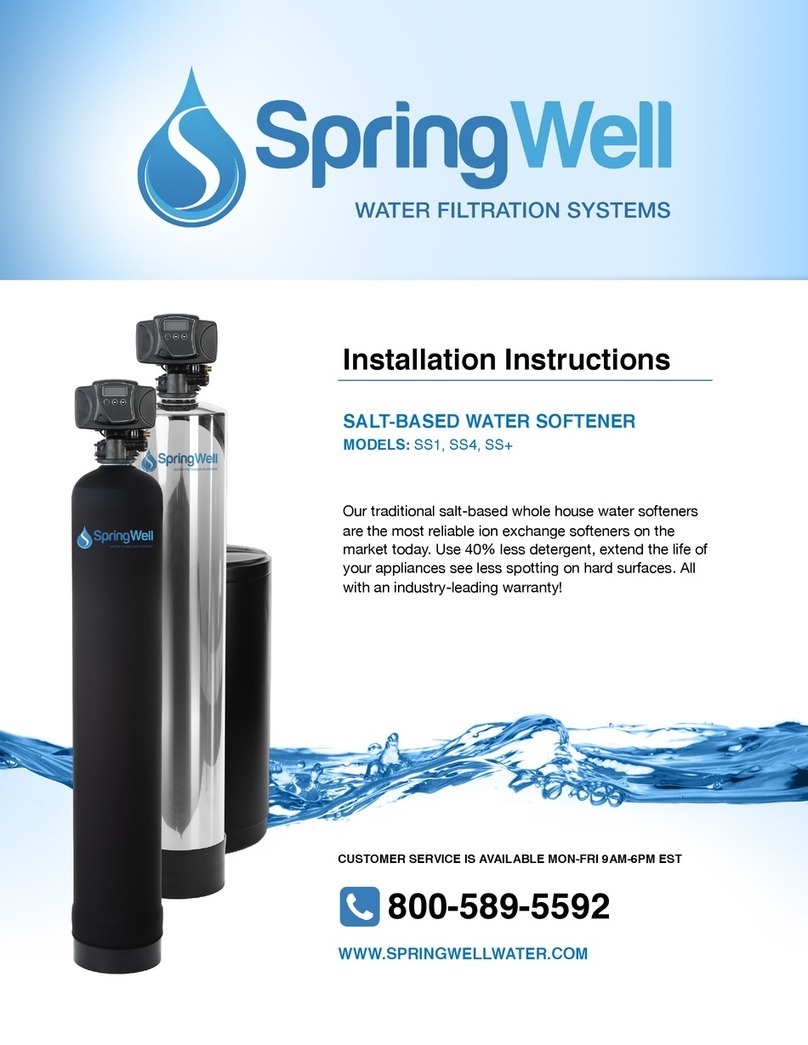
Spring Well
Spring Well SS+ installation instructions

Black & Decker
Black & Decker 900149 user manual
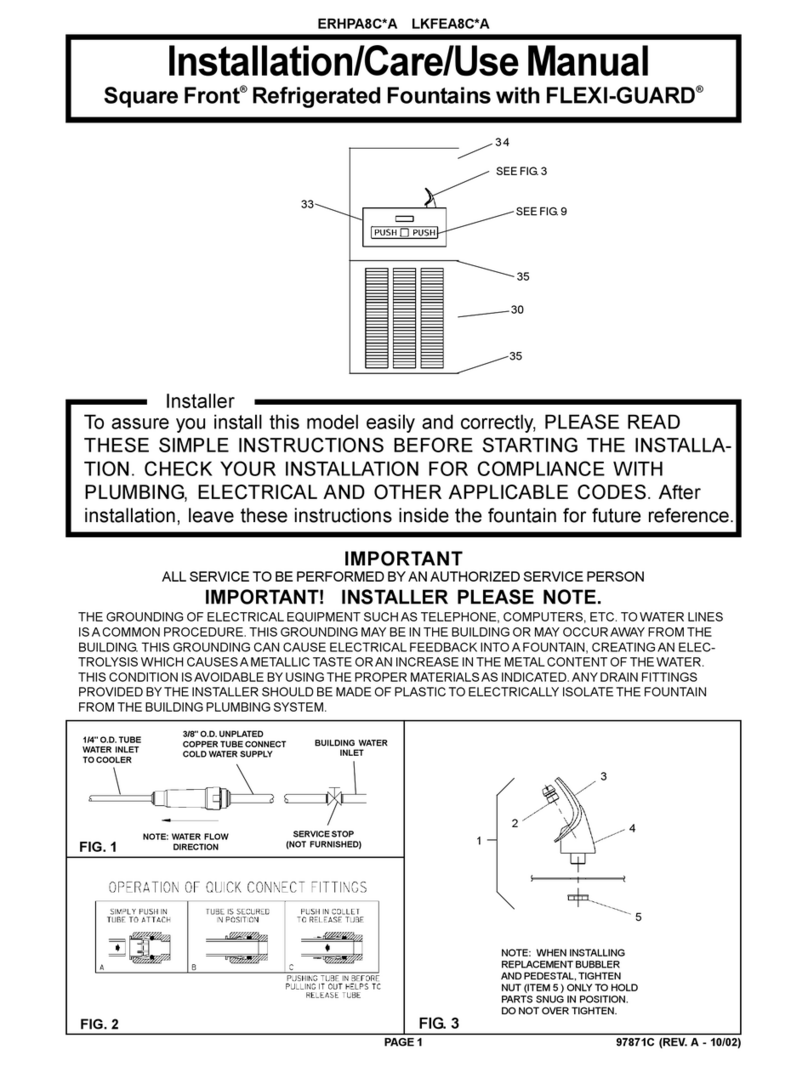
Elkay
Elkay Square Front LKFEA8C A Series Installation, care & use manual
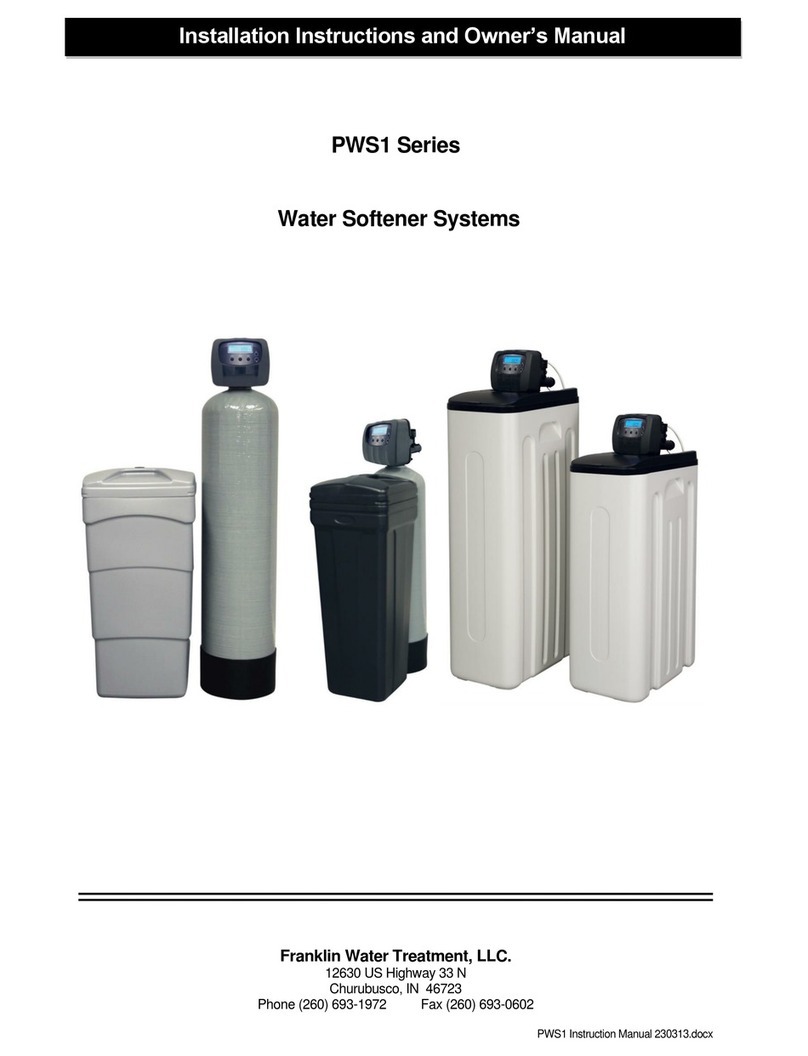
Franklin
Franklin PWS1 Series Installation instructions and owner's manual

vitapur
vitapur VWD1076BLST Use & care guide

